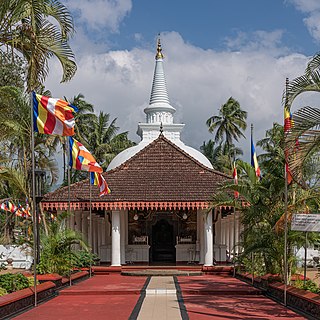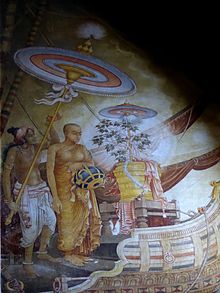
The Bodhi Tree, also called the Mahabodhi Tree, Bo Tree, is a large sacred fig tree located in Bodh Gaya, Bihar, India. Siddhartha Gautama, the spiritual teacher who became known as the Buddha, is said to have attained enlightenment or buddhahood circa 500 BCE under this tree. In religious iconography, the Bodhi Tree is recognizable by its heart-shaped leaves, which are usually prominently displayed.

Saṅghamittā was an Indian Buddhist nun and believed to be the eldest daughter of Emperor Ashoka and his first wife and Empress, Devi. Together with her brother Mahinda, she entered an order of Buddhist monks. The two siblings later went to Sri Lanka to spread the teachings of Buddha at the request of King Devanampiya Tissa who was a contemporary of Ashoka. Ashoka was initially reluctant to send his daughter on an overseas mission. However, because of the insistence of Sangamitra herself, he finally agreed. She was sent to Sri Lanka together with several other nuns to start the nun-lineage of Bhikkhunis at the request of King Tissa to ordain queen Anulā and other women of Tissa's court at Anuradhapura who desired to be ordained as nuns after Mahindra converted them to Buddhism.

Tissa, later Devanampiya Tissa, meaning, was one of the earliest kings of Sri Lanka based at the ancient capital of Anuradhapura. According to the traditional chronology, he ruled from 307 BC to 267 BC, but the modified chronology adopted by modern scholars such as Wilhelm Geiger assigns his reign to 247 BC to 207 BC. His reign was notable for the arrival of Buddhism in Sri Lanka under the aegis of the Mauryan Emperor Ashoka the Great. The primary source for his reign is the Mahavamsa, which in turn is based on the more ancient Dipavamsa.

Thuparamaya is the earliest documented Buddhist temple in Sri Lanka. Its building dates to the arrival of Mahinda Thera (Mahindagamanaya) and the introduction of Buddhism to the island.

The Samadhi Buddha is a famous statue situated at Mahamevnāwa Park in Anuradhapura, Sri Lanka. The Buddha is depicted in the position of the Dhyana Mudra, the posture of meditation associated with his first Enlightenment. This statue is 7 feet 3 inches in height and carved from dolomite marble.. It is similar to the Toluvila statue from the same period. It is similar to Gupta period Buddha images, it is believed that originally the image was gilded and had inlaid eyes made of precious gems. It is likely that it was one of the four statues around a sacred Bodhi tree shrine. This is the only one that has survived largely intact.
Atamasthana or Eight sacred places are a series of locations in Sri Lanka where the Buddha had visited during his three visits to the country. The sacred places are known as Jaya Sri Maha Bodhiya, Ruwanwelisaya, Thuparamaya, Lovamahapaya, Abhayagiri Dagaba, Jetavanarama, Mirisaveti Stupa and Lankarama. They are situated in Anuradhapura, the capital of the ancient Anuradhapura Kingdom.

Stupas, also called dagebas and cetiyas, are considered an outstanding type of architectural creation of ancient Sri Lanka. Under the influence of Buddhism, there were several changes in the field of architecture in Sri Lanka. The stupa commands a prominent place among these changes. The Stupa is also known by synonymous names such as Chaithya, Dagaba, Thupa, Seya and Vehera. Stupas designed and constructed in Sri Lanka are the largest brick structures known to the pre-modern world.

Reswehera Rajamaha Vihara is an ancient temple which was built by the king Devanampiya Tissa (307BC-267BC) situated in North Western Province in Sri Lanka.

Anuradhapura Kingdom, named for its capital city, was the first established kingdom in ancient Sri Lanka related to the Sinhalese people. According to the Mahāvaṃsa, it was founded by King Pandukabhaya in 437 BC, whose authority extended throughout the country.

Muthiyangana Raja Maha Vihara is an ancient Buddhist temple located in the middle of Badulla town in the Badulla District of Uva Province in Sri Lanka.
The Port of Jambukolapattinam or Dambakola Patuna is an ancient port to the north of Jaffna, in the Northern Province, Sri Lanka.

Mahamevnāwa is an ancient park in Anuradhapura, Sri Lanka. It was created by King Mutasiva whose name is in the history as the first king who structured a park. He who was the son of King Pandukabhaya and the father of King Devanampiya Tissa.
Sirimeghavanna, also known as Kirthi Sri Meghavarnabhaya and Kithsiri Mevan was King of Anuradhapura in the 4th century. According to the traditional chronology, he ruled during 304–332 CE; the modified chronology adopted by modern scholars such as Wilhelm Geiger assigns his reign to 352–379 CE.

Bellanwila Rajamaha Viharaya is a Buddhist temple situated in Bellanwila, Colombo District, Sri Lanka. Located around 12 km south to the Colombo city, near Dehiwala - Maharagama road, the temple attracts hundreds of devotees daily and is famous for its annual Esala Perehera festival which usually takes place in the month of August or September. One of the most venerated Buddhist temples in Sri Lanka, many devotees flock to worship the sacred Bo tree of Bellanwila Rajamaha Vihara, which is considered to be one of the first offshoots of Jaya Sri Maha Bodhi in Anuradhapura, Sri Lanka. The present chief incumbent of Bellanwila Rajamaha Vihara is Ven. Dr. Bellanwila Dhammaratana Nayaka Thera.

The Sinhalese monarchy has its origins in the settlement of North Indian Indo-Aryan immigrants to the island of Sri Lanka. The Landing of Vijay as described in the traditional chronicles of the island, the Dipavamsa, Mahavamsa and Culavamsa, and later chronicles, recount the date of the establishment of the first Sinhala Kingdom in 543 BC when Prince Vijaya, an Indian Prince, and 700 of his followers are claimed to have landed on the island of Sri Lanka and established the Kingdom of Tambapanni. In Sinhalese mythology, Prince Vijaya and followers are told to be the progenitors of the Sinhalese people. However according to the story in the Divyavadana, the immigrants were probably not led by a scion of a royal house in India, as told in the romantic legend, but rather may have been groups of adventurous and pioneering merchants exploring new lands.

Ancient Kantharodai Historical Site with some remains of Stupas is situated in Kandarodai village in Chunnakam, Sri Lanka. The temple is considered one of the ancient Buddhist remains in existence today in Jaffna Peninsula.

Seema Malaka is a Buddhist temple in Colombo, Sri Lanka. The temple is mainly used for meditation and rest, rather than for worship. Situated in the Beira Lake, the temple was originally constructed in the late 19th century. Seema Malaka is a part of the Gangaramaya Temple and is situated few hundred meters to its east.

Kasagala Raja Maha Vihara is an ancient Buddhist Temple, situated in Angunukolapelessa, Hambantota District, Sri Lanka. It is situated about 10 km (6.2 mi) away from Ranna Junction along Ranna - Weeraketiya road. The temple has been formally recognised by the Government as an archaeological site in Sri Lanka. The designation was declared on 6 June 2008 under the government Gazette number 1553.

Sri Subodharama Raja Maha Vihara is a historic Buddhist temple situated at Dehiwala in the Western province, Sri Lanka. The temple is located at the Dehiwala junction on the Colombo-Galle main road, about 9 miles south of Colombo city. The temple has been formally recognised by the Government as an archaeological site in Sri Lanka. The designation was declared on 23 February 2007 under the government Gazette number 1486.

Aramanapola Raja Maha Vihara or Ganegama Rankoth Vihara is an ancient Buddhist temple in Ganegama, Sri Lanka. The Vihara is located approximately 2.5 km (1.6 mi) far away from the Pelmadulla town on Colombo - Batticaloa main road (A4). The temple has been formally recognised by the Government as an archaeological site in Sri Lanka. The designation was declared on 2 March 1951 under the government Gazette number 10217.
























